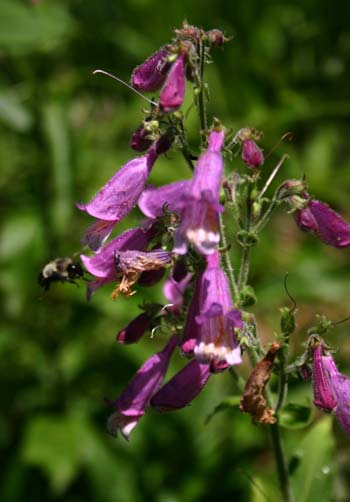Musings

Here’s a map of distribution of fluted points (loosely “arrowheads,�? but they were really spear points or knives) by county across the US (mostly), current as of 1998, with the density reflected in the darkness of the blobs. The fluted points were made by the peoples who successfully colonized the New World, although there may have been earlier arrivals who did not leave genetic or linguistic evidence of their presence. These data suggest the fluted-point people did not arrive along an ice-free corridor through the Rockies, but instead worked their way considerably southward along the Pacific coast, then crossed eastward from what’s now southern California. Although there’s discussion of earlier and later arrivals from Europe/Greenland, this bunch came from Asia. These fluted points date to the 1500 years prior to 11,200 years ago.
John and I heard the latest on this from Dave Anderson, at a lecture at Fernbank (site loads slowly) recently.
Map from: Anderson, David G., and Michael K. Faught. 1998. The Distribution of Fluted Paleoindian Projectile Points: Update 1998. Archaeology of Eastern North America 26:163–87.
Posted at 5:41 PM |
Comments Off on Fluted points

Obviously, Doonesbury/Trudeau. Last Sunday.
And, you, what are your major chill groups?
Is this question too similar to those lists in personal ads—”must like movies, sunsets, and puppies?” Or “wine, women, and song?”
Based on the content of these musings, I guess my list has flowers, food, and a small measure of feistiness. Or maybe it’s not alliterative at all (back to the drawingboard).
Posted at 8:13 PM |
Comments Off on Chill groups

I know the stars say we’re not there yet, but by my personal gauge, summer is here. It’s hot. It’s dry. The days are long. And did I say hot?
So, we’ve adjusted our menu: summer chicken salad, with grapes and apples, and with the mayo cut with some plain yoghurt. Mmmm!
Posted at 7:55 PM |
4 Comments »

Kudos to GRS for this image.
The dictionary says “amaryllis”? is from the Greek Amarullis, the name for shepherdess in mythology and pastoral poetry. And this one is living in the country, in Ingham County in southern Michigan. Don’t you just love the pollen adorning the petal?
Posted at 6:50 PM |
Comments Off on Amarullis/amaryllis

Here are some scary numbers, like the current Earth population, in real time. Keep scrolling down, and you’ll find some figure that will shock you. Forest loss this year? The imbalance of energy produced and energy consumed?
Posted at 10:22 PM |
Comments Off on Scary numbers

Seattle sign, courtesy jcb.
Sometimes I check out Arts and Letters Daily, which is a digest of essays, reviews, and the like, some well-written and moderately interesting. Today I found a link to a John Cornwell review of Peter Woit’s new book, Not Even Wrong: The Failure of String Theory and the Continuing Challenge to Unify the Laws of Physics, in which he argues against string theory, which is a big deal these days in physics research. Cornwell says
String theory, he avers, has become a form of science fiction. Hence his book’s title, Not Even Wrong: an epithet created by Wolfgang Pauli, an irascible early 20th-century German physicist. Pauli had three escalating levels of insult for colleagues he deemed to be talking nonsense: “Wrong!�?, “Completely wrong!�? and finally “Not even wrong!�?. By which he meant that a proposal was so completely outside the scientific ballpark as not to merit the least consideration.
I had never encountered Pauli’s three levels of incorrect, mistaken, in error, erroneous, inaccurate, inexact, imprecise, fallacious, wide of the mark, off target, unsound, and faulty (list courtesy of Apple’s built-in dictionary), but I am ready to use them!
I hate to say that the extent of knowledge that many students get from high school means my friends who are teaching undergraduates have reams of their students’ answers to test questions that are easy to deem “not even wrong.�? Note that many are “graduating literate” and prepared for college, and I think life, see Mouse’s blahg.
Posted at 5:56 PM |
Comments Off on Three wrongs

Nostalgia sign (me), courtesy jcb.
Sometimes I poke around on the web and find something really useful. Yesterday it was a list of Latin phrases, with translations courtesy of Wikipedia. The bad side of this info is that once again my ignorance is revealed….
Then you find a phrase like sesquipedalia verba (words a foot and a half long) and you start wondering how you can work it into a conversation.
Posted at 8:59 PM |
2 Comments »

It’s not just the pack, but the goofy hat, too.
I’m not sure of the pathology of this poor tree (probably an oak?) we found trailside last weekend, but that growth is distinctive even with the bark gone. If I had to guess, I’d say virus, but???
Since I never see myself with my revered and long-lived Mountainsmith pack, I often forget how different it looks from other daypacks—droopy-butt I think was the (endearing?) term once used. I just checked the Mountainsmith web page, and their lumbar packs—which is what mine is, essentially—are all shorties, and lacking shoulder stabilizing straps like mine. I love how this pack puts all the weight on my hips, with nothing on the shoulders. I can carry it stuffed with heavy academic books, and I mean heavy, and I feel the weight, but no strain on my upper body. Just as the pack was engineered!
Browsing the Mountainsmith offerings, if I had to replace my pack (knock on wood!), I might go with something like the Lily model, with important features like bite valve catch, hydration compatible with exit port, and key clip (in no particular order).
I used to think a hydration system was a little too, too, but, having tried it in the hot, humid, Deep South, I’m a total convert. I now use a Platypus set-up that’s like a heavy-duty Ziploc bag that I drop into my pack. The delivery tube is that whitish line on top of my shoulder strap.
The special charm of this photo (TY jcb): me and the tree, we’re both lumpy.
Posted at 1:58 PM |
2 Comments »

Flame or wild azalea? I’m leaning to flame….

I’m guessing some kind of Penstemon?
I pass along a couple of mysteries from Saturday’s high-altitude (or what passes for high altitude in Georgia) walk, up in the Raven Cliffs Wilderness on the divide between the Little Tennessee River and the Chattahoochee River drainages.
I was astounded to find azaleas still abloom, and even one plant with the blooms not yet opened! These delicate tree versions make the yard ones seem, I guess, just what they are: showy. I love the exaggerated length of the flower parts, very elegant!
I’m stumped on the pink tubular flowers, but after digging in my wildflower book and dipping into the web just a tad, I’m guessing its one of an apparently nearly limitless list of Penstemons. Anyone else?
I know this sample’s past its prime, but the busy bee caught my eye. And she was busy! She would walk all the way into each flower, so not even her nether parts stuck out!
Posted at 4:01 PM |
Comments Off on Two blooms

Wilber B. Huston in 1997.
John and I were honored that my mother’s first cousin, Bill Huston, and his wife Dot, came to our wedding. Sadly, they’re both gone now. Bill was famous in the family lore for several reasons. One of my favorite family tales was when Bill, at about three years of age, was sent outdoors to play. He and his parents were staying at the Brotherton Pea Farm, in Luce County, Michigan, where Bill’s uncle and namesake (Wilber Brotherton), did botanical magic crossing English peas to come up with tasty varieties. Out wandering, young Bill discovered these lovely little sticks stuck in soft soil, easy to pull up and collect. Adults, however, reacted with consternation, discovering Bill’s pile of labels removed from the rows of peas.
Despite this early foray into ignorance, Bill was once known as “the brightest boy�? of 1929, when he won a national scholarship from Thomas Edison. One question that clinched it: when is it permissible to lie? The family lore (one version anyway) has it that when Bill was overwhelmed by the notoriety of winning the scholarship, my grandmother bundled him into a car, I think along with a buddy, and took them to the Pea Farm, to escape. Even then, paparazzi were exceedingly rare in the Upper Peninsula.
Links of interest: obituaries in the New York Times, Washington Post, and local papers in Arizona, his final home, the Arizona Republic and the Fountain Hills Times. Also, blogger Laurence Jarvik mentioned Bill…. (Thanks jcb for the detective work.) You can find a substantial family genealogy page authored by Bill’s son Herb here, which is dedicated in part to my grandmother, Edith Brotherton McKinney, the get-away driver. And here’s Wilber Brotherton’s dissertation listing at the University of Michigan library.
See, botanists on both sides in my family!
Posted at 12:58 PM |
Comments Off on Uncle Bill










